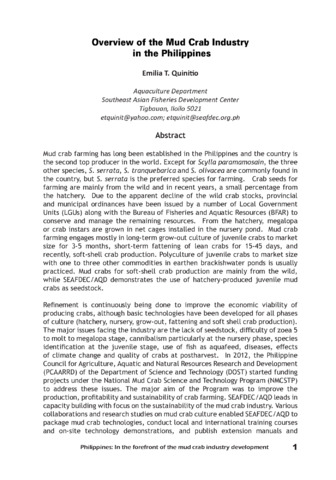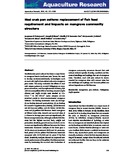Development of protocol for the production of hatchery-reared mud crab Scylla serrata juveniles for soft-shell crab farming
- Global styles
- MLA
- Vancouver
- Elsevier - Harvard
- APA
- Help

Date
2017Page views
17,571ASFA keyword
AGROVOC keyword
Taxonomic term
Metadata
Show full item record
Share
Abstract
Development of economically viable techniques for growing hatchery-reared juvenile crabs to suitable sizes will address the problem on the source of seed stocks for soft-shell crab farming. This paper reports the production of hatchery-reared mud crab Scylla serrata from juveniles in the nursery to 73-106 g body weight (BW) crabs in the grow-out pond for the individual system soft-shell crab farming. Likewise, the performance of hatchery-reared S. serrata, and wild S. tranquebarica and S. olivacea juveniles was determined in the soft-shell crab production set-up.The BW increased from 1.8-1.9 g to 78-113.7 g when stocked at 0.5 ind m-2 and from 1.6-2.3 g to 73-106.7 g at 1.0 ind m-2 after 75 days. Growth rates at both stocking densities were comparable. However, survival was significantly higher (P<0.05) in lower (63.6~c1.01%) than in higher (35.6~c3.34%) stocking density. Male S. serrata (46.0 ~c 1.75%) had significantly higher BW increase than females (39.4 ~c 2.05%). Crabs stocked at sizes of 51-60 g showed significantly greater percent increase in BW (43.26~c 0.98%) compared with those at 61-70 g (40.98~c1.33%), 71-80 g (38.55~c 1.04%), 81-90 g (36.34 ~c 1.27%) and 91-100 g (38.52 ~c 1.67%). Among the three species, hatchery-reared S. serrata (42.14 ~c 1.34%) had significantly higher mean percent BW increase compared with S. olivacea (38.23 ~c 0.49%) and S. tranquebarica (36.16 ~c 0.78%). S. serrata had significantly shorter mean culture period (24.11 ~c 0.95 days) than S. tranquebarica (28.48 ~c 0.54 days) and S. olivacea (28.75 ~c 0.34 days).
Suggested Citation
Quinitio, E. T., Libunao, G. X., & Parado-Estepa, F. D. (2017). Development of protocol for the production of hatchery-reared mud crab Scylla serrata juveniles for soft-shell crab farming. In E. T. Quinitio, F. D. Parado-Estepa, & R. M. Coloso (Eds.), Philippines : In the forefront of the mud crab industry development : proceedings of the 1st National Mud Crab Congress, 16-18 November 2015, Iloilo City, Philippines (pp. 28-38). Tigbauan, Iloilo, Philippines: Aquaculture Department, Southeast Asian Fisheries Development Center.
Type
Conference paperISBN
9789719931072Collections
Related items
Showing items related by title, author, creator and subject.
-
Mud crab pond and pen culture
Rodriguez, Eduard M. (University of the Philippines Aquaculture Society, Inc, 2001) -
Overview of the mud crab industry in the Philippines
Mud crab farming has long been established in the Philippines and the country is the second top producer in the world. Except for Scylla paramamosain, the three other species, S. serrata, S. tranquebarica and S. olivacea ... -
Mud crab pen culture: replacement of fish feed requirement and impacts on mangrove community structure
Primavera, Jurgenne ; Binas, Joseph B.; Samonte-Tan, Giselle P. B.; Lebata, Ma. Junemie J.
; Binas, Joseph B.; Samonte-Tan, Giselle P. B.; Lebata, Ma. Junemie J.  ; Alava, Veronica R.; Walton, Mark; LeVay, Lewis (Blackwell Publishing, 2010)
Brackishwater pond culture has been a major factor in mangrove loss in Southeast Asia, hence, the need to develop environment-friendly technologies such as mud crab Scylla (Portunidae) culture in mangrove pens exists. This ...
; Alava, Veronica R.; Walton, Mark; LeVay, Lewis (Blackwell Publishing, 2010)
Brackishwater pond culture has been a major factor in mangrove loss in Southeast Asia, hence, the need to develop environment-friendly technologies such as mud crab Scylla (Portunidae) culture in mangrove pens exists. This ...





